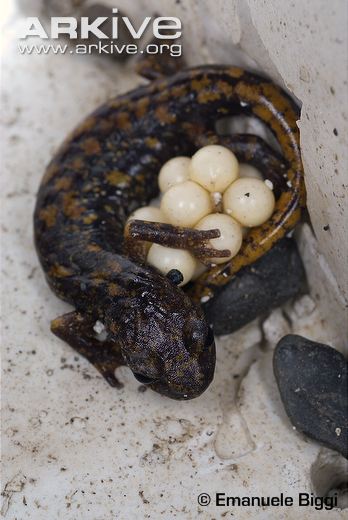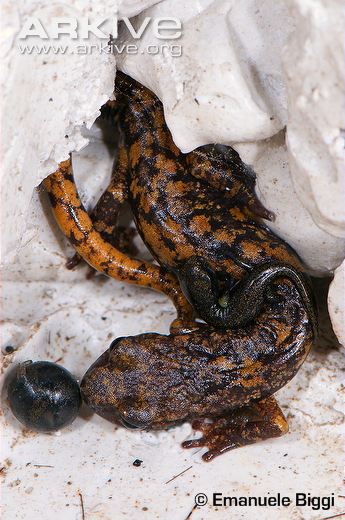How does this organism reproduce?
How do most animals produce?
During sexual reproduction among animals, there is a fusion of two
haploid gametes from each parent, which come together to form a zygote
(diploid cell). After this process, the cells replicate and mature
through mitosis. Mitosis will give rise to an adult animal.
Then, this animal now has to ability to sexually reproduce, with
another animal in their species by using half of their gametic
cells. Thus starting the process over again (Campbell 2008).
Specifically, how does Speleomantes strinatii reproduce?
 Salamanders usually partake in seasonal mating (Reptiles of
amphibians de France 2004). Speleomantes strinatti commonly mate
in the spring. The male initiates sexual reproduction by touching
and smelling another salamander to determine that salamander’s sex.
If he finds a female, he places himself in front of her and deposits
a spermatophore. The female then intakes the sperm for internal
fertilization. During this action, the male moves his place back and
forth similar to a dance (Reptiles of amphibians de France 2004).
Females are usually slightly larger than males (Salvidio and Bruce
2006). Salamanders’ reproduce sexually in moist environments
(Reptiles & amplibiens de France 2004). Most gravid or pregnant
females are found in the fall (Salvidio et al. 1992). These eggs are
about 5 to 6 mm in diameter and are laid individually of each other
(Salvidio et al. 1992). A clutch contains about 6-14 eggs (Salvidio
et al. 1992). These eggs are usually laid on moist rocks in between
small cracks of the terrain (Salvidio et al. 1992). They have a
white/ivory color. (Zug et al. 2001). The juvenile salamanders are
about 20 mm long, although they will eventually grow to be 115 mm to
130 mm long (Zug et al. 2001).
Salamanders usually partake in seasonal mating (Reptiles of
amphibians de France 2004). Speleomantes strinatti commonly mate
in the spring. The male initiates sexual reproduction by touching
and smelling another salamander to determine that salamander’s sex.
If he finds a female, he places himself in front of her and deposits
a spermatophore. The female then intakes the sperm for internal
fertilization. During this action, the male moves his place back and
forth similar to a dance (Reptiles of amphibians de France 2004).
Females are usually slightly larger than males (Salvidio and Bruce
2006). Salamanders’ reproduce sexually in moist environments
(Reptiles & amplibiens de France 2004). Most gravid or pregnant
females are found in the fall (Salvidio et al. 1992). These eggs are
about 5 to 6 mm in diameter and are laid individually of each other
(Salvidio et al. 1992). A clutch contains about 6-14 eggs (Salvidio
et al. 1992). These eggs are usually laid on moist rocks in between
small cracks of the terrain (Salvidio et al. 1992). They have a
white/ivory color. (Zug et al. 2001). The juvenile salamanders are
about 20 mm long, although they will eventually grow to be 115 mm to
130 mm long (Zug et al. 2001).
The photo above was photographed by Emanuele Biggi from
Arkive.org.
This is a photo of an female Speleomantes strinatii watching over
her eggs.
Do these salamanders continue to nurture their young after they are
hatched?
 During
my research on the reproduction characteristics of
Speleomantes strinatii, I found an experimental case study examining
the parental care of salamanders. This experimental research was
conducted by Fabrizio Oneto, Dario Ottonello, Mauro Valerio
Pastorino, and Sebastiano Salvidio (2010). The test subject for
this experiment was Speleomantes strinatii. Before this
experiment, there was an absence of evidence of post-hatching
parental care among salamanders. This trait is also observed among
other amphibians such as frogs and caecilians. The basic method of
their
experiment was to use an infrared camera to observe the pregnancy
and hatching stages of Speleomantes strinatii. This experiment spanned from
egg deposition until birth site abandonment. The conditions of this
experiment were semi natural and completely dark. The results of
this experiment show great significance in the reproduction of
salamanders. The results showed that female salamanders lay multiple
eggs in concaved, moist areas of the salamanders’ preferred terrain.
The female salamander was observed showing anti-predator behaviors
towards multiple organisms near the birthing site. During the
brooding stage, the female spent the majority of her time with the
clutch rather than going out to look for food. Once two of her eggs hatched, the juveniles remained in the
birthing site with her for six weeks. During these six weeks, the
young were observed climbing onto the mother salamanders’ body,
laying on her for hours at a time (Oneto et al. 2010).
During
my research on the reproduction characteristics of
Speleomantes strinatii, I found an experimental case study examining
the parental care of salamanders. This experimental research was
conducted by Fabrizio Oneto, Dario Ottonello, Mauro Valerio
Pastorino, and Sebastiano Salvidio (2010). The test subject for
this experiment was Speleomantes strinatii. Before this
experiment, there was an absence of evidence of post-hatching
parental care among salamanders. This trait is also observed among
other amphibians such as frogs and caecilians. The basic method of
their
experiment was to use an infrared camera to observe the pregnancy
and hatching stages of Speleomantes strinatii. This experiment spanned from
egg deposition until birth site abandonment. The conditions of this
experiment were semi natural and completely dark. The results of
this experiment show great significance in the reproduction of
salamanders. The results showed that female salamanders lay multiple
eggs in concaved, moist areas of the salamanders’ preferred terrain.
The female salamander was observed showing anti-predator behaviors
towards multiple organisms near the birthing site. During the
brooding stage, the female spent the majority of her time with the
clutch rather than going out to look for food. Once two of her eggs hatched, the juveniles remained in the
birthing site with her for six weeks. During these six weeks, the
young were observed climbing onto the mother salamanders’ body,
laying on her for hours at a time (Oneto et al. 2010).
The photo above was photographed by Emanuele Biggi from
Arkive.org.
This is a photo of a female Speleomantes strinatii watching
over her young offspring, which can be found on her backside.
Wow! There are many parts to this organisms life cycle!
Explore the next page which includes information on what organisms
interact with this species.
Return to Home Page.
